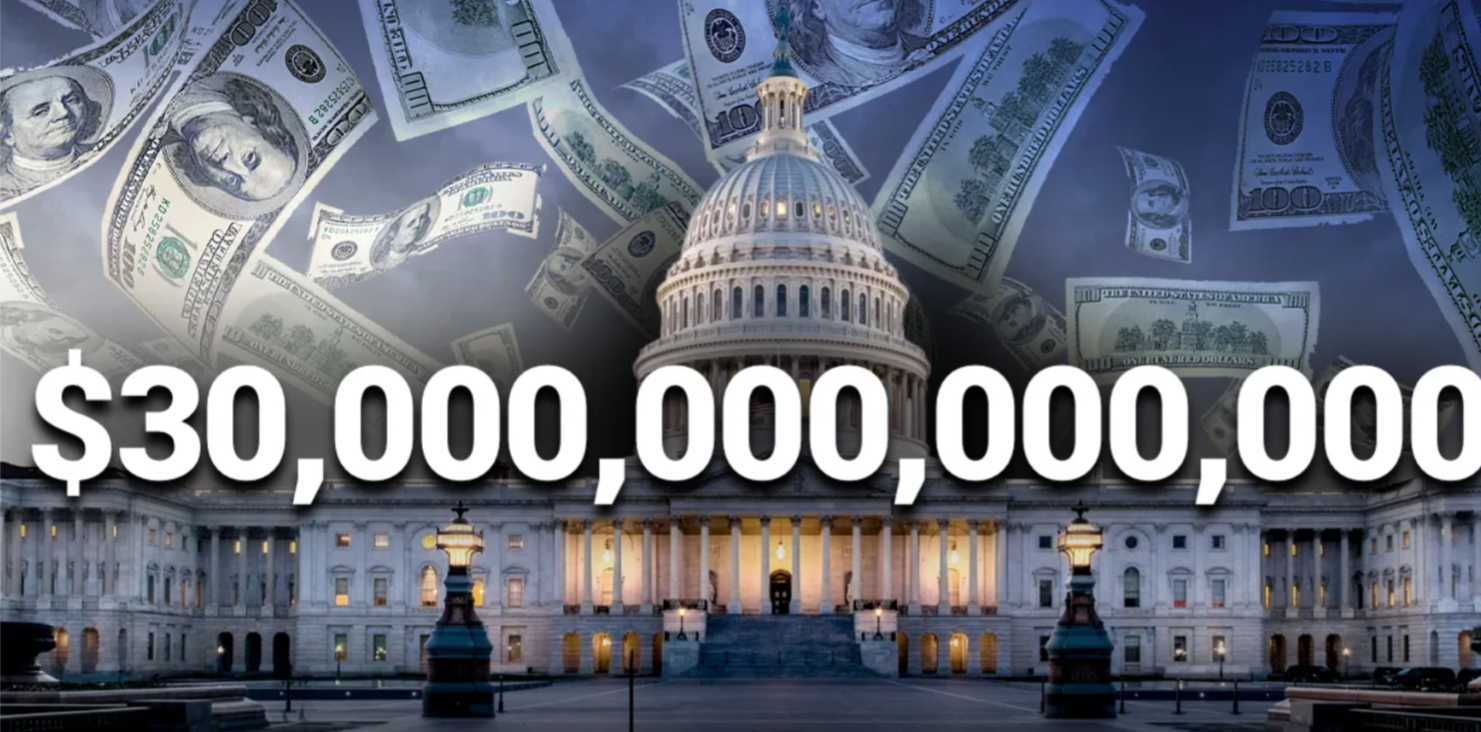(ThyBlackMan.com) In 1980, America’s publicly held debt reached more than $712 billion (about $2.8 trillion in 2025 dollars), or roughly 25% of annual U.S. GDP. Today, that figure is a little over $30 trillion, or around 100% of GDP. And as the federal debt grew 42 times larger over that span, the economy grew only tenfold. You can’t expand the numerator four times faster than the denominator for 45 years without courting economic danger.

That’s where we find ourselves. The U.S. is at peace, and despite President Donald Trump’s claims, there’s no national emergency. And yet we’ve only seen debt as a higher share of GDP during the years of 1945, 1946, 2020 and 2021. Then, Republicans and Democrats knew to scale back. Now, debt explodes during emergencies and continues to grow in peacetime.
In 1946, after World War II, debt-to-GDP was 106%. It declined to just 25% by 1980, not only because of inflation and economic growth but because of real fiscal discipline. With budgets nearly balanced, the fruits of a booming private sector could actually reduce the burden. Beginning in the Reagan era, discipline gave way to a new normal of chronic budget deficits.
Three forces made the shift possible:
First, and the main cause of the mess we are in, is that the entitlement state became enormous yet untouchable. The Social Security reforms of 1983 are a rare example of bipartisan structural reform of a major entitlement program in U.S. history. Since then, despite economic and societal changes, the program has never been reformed. Never mind that it faces insolvency and the potential for automatic benefit cuts of more than 20% in 2033. The same is true of our other major debt driver: Medicare. And Medicaid is growing far beyond its original intent.
Democrats, occasionally helped by Republicans, have worked to expand welfare programs meant for lower-income people to those in higher and higher income brackets. The most recent and extreme example is the COVID-19-era expansion of the Obamacare tax credit to wealthier taxpayers, a significant share of whom enjoy early retirement. The fight over its continuation is what the government shutdown is about.
Second, Republicans discovered that promising tax cuts without offsetting spending cuts was politically painless so long as one claims that they “pay for themselves.” There is one rare and recent exception: this year’s “One Big Beautiful Bill,” which included $1.5 trillion in spending reductions over 10 years to offset some of the tax cuts. It’s not enough, but it’s something. Meanwhile, the Democrats love to claim that debt wouldn’t be a problem if the rich paid their “fair share.” They already do pay an enormous amount in taxes. But the numbers still don’t add up.
Finally, the Federal Reserve, starting under then-Chairman Alan Greenspan in 1987, learned how to anesthetize the political pain of budget deficits by keeping interest rates artificially low and monetizing debt. Politicians concluded that they could borrow endlessly without suffering political consequences. The problem is that this only works insofar as investors don’t worry that they will be paid back with inflated dollars.
That illusion has vanished. Interest costs have surged from $372 billion annually just a few years ago to nearly $1 trillion today, surpassing what we spend on defense or Medicaid. Within a decade, yearly interest payments are projected to nearly double, reaching $1.8 trillion. Even without new programs, the built-in deficit would keep rising and outpace economic growth. And Washington keeps adding more deficit spending.
This decade’s bipartisan binge has debt on track for 166% of GDP by 2054. I don’t think we will actually reach that point, because inflation will break out and stabilize the debt. That would destabilize the country and inflict enormous amounts of pain and lost purchasing power. So, my point remains: Politicians on the left and right see that the debt is exploding and are doing nothing.
The current politics of this crisis are as bipartisan as its origins. Democrats defend every entitlement and dream up new benefits. Republicans demand more defense spending and still more tax cuts. Both claim that faster growth will somehow erase the arithmetic, but growth alone can’t close a structural gap this large.
Even sustained 3% real annual growth — a questionable assumption given the implications of an aging population and crackdown on immigration — would produce about $4.4 trillion in extra revenue over a decade, while total deficits will total $21.7 trillion.
Don’t be fooled: The debt explosion is not driven by waste, fraud or foreign aid. Nor is it the result of a lack of revenue. It’s the direct result of reckless promises to retirees, the cost of health care and an unwillingness to pay the bills honestly. For most of American history, debt fell when wars ended and peace returned. Since 1980, we’ve managed the opposite: peace without prudence and prosperity without restraint.
Written by Veronique de Rugy
Official website; http://twitter.com/veroderugy

















I read your article where you speak of debt as being the major issue in the United States. I disagree with you.
Consistent growth is our major challenge, as if the United States can put itself on a sustained path of economic growth, it will erase its debt over a period of time. The definition of economic growth is thriving (a nation of prosperity), flourishing and blooming.
This means influencers like yourself, “with a consistent voice,” if you promote a message of economic growth, that should influence politicians to speak of and study how to grow our economy rather than control and concentrate on our debt. A constant message saying, “We need to grow the American economy” conjures up a healthy economy. Growth means new revenues as a result of the production of new revenue streams.
Just as we are having this conversation and pivoting to speaking about economic growth, the inevitable question arises, “How do you grow a “$20 trillion plus U.S. economy.” Well, you go to the question of the core, of what made the U.S. economy, the largest economy in the world in the first place. It certainly wasn’t spending on programs like Social Security, health care, and giving billionaires, millionaires and corporations tax cuts, as you have pointed out adds to our deficits.
The success of the United States owes its accomplishment as being the # 1 and largest economy in the world to Consumers Spending money. Consumer spending is 70% of GDP. Economic growth doesn’t come from trickle-down revenue due to tax cuts for billionaires, millionaires and corporations. It comes from consumers with disposable income to spend. When consumers spend, businesses grow customers, leading to jobs and an economy that truly lifts all boats.
So, we need to promote a long-term Consumer Spending driven economy to politicians. How do you create such an economy; you do it through giving consumers who are 70% of the nation’s GDP a 10-year 10% tax cut, which will pay for itself because a Consumer Driven economy will produce new revenue streams that can be taxed. Go TheFixThisTime.com for details.